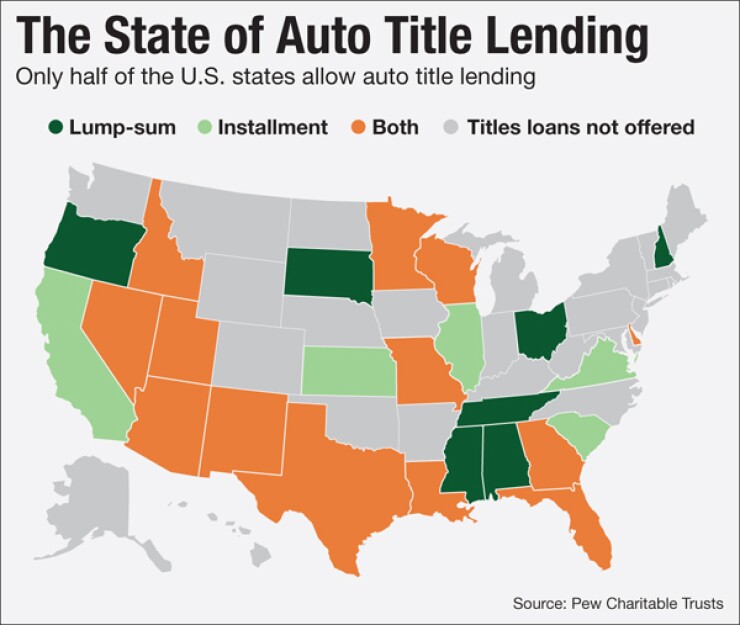
Academics are challenging the Consumer Financial Protection Bureau's study of auto title loans, calling the findings inconsistent with state data.
The agency's
But some states report vehicle repossessions rates of between 6% and 11%, far lower than the CFPB's figures, said Jim Hawkins, an associate law professor at the University of Houston Law Center. Texas had the highest repossession rate of 9.94% in 2013, said Hawkins, who has analyzed repossession rates in seven of the 25 states that allow single-payment auto title loans.
-
The Consumer Financial Protection Bureau found that one in five borrowers who take out short-term auto title loans have their vehicle seized for failing to repay the loan.
May 18 -
The bureau said Wednesday that it plans to hold a public hearing in Kansas City, Mo., to discuss small-dollar lending. The hearing will be held at the Kansas City Convention Center and will feature remarks from CFPB Director Richard Cordray, as well as testimony from consumer groups, industry representatives and the public.
May 18 -
Payday lenders on Wednesday pushed back against Google's plan to ban payday loan advertisements, arguing it was discriminatory and "a form of censorship."
May 11 -
At least three large U.S. banks are preparing to go to market with new small-dollar installment loan products in a move that could potentially disrupt the payday lending industry.
May 6
"Title loan borrowers experience relatively low rates of repossession," Hawkins said. "It seems to me the CFPB is coming up with very different data than anything we've seen before."
The study is important because the CFPB is set next week to
Auto title loans are short-term, high-cost loans where the consumer uses a paid-off vehicle as collateral. The loans typically are for up to $1,000 and must be paid in full after a month, often consuming 50% of a borrower's gross monthly income, according to the Pew Charitable Trusts.
The CFPB's study specifically sought to measure the number of times a loan is reborrowed, and found that 80% of auto title loans are reborrowed the same day an initial loan is repaid. Only one out of eight loan sequences consist of a single loan that is repaid without reborrowing, the CFPB found.
Alex Horowitz, a senior officer of the small-dollar loans project at Pew, said the discrepancy in repossession rates can be explained by how individual loans and multiple loan sequences are counted in a calendar year.
The CFPB measures subsequent loans made within a short period of time, typically 60 days, after a previous loan is repaid. These so-called loan sequences are counted over a 12-month rolling period, said Horowitz, while state data is limited to loans counted in a calendar year.
So, if 100 borrowers took out an auto title loan in September 2015, and 80% of the borrowers paid off the loan after reborrowing through March 2016, the states would show an average repossession rate of 10% over the two-year period, Horowitz found. Meanwhile, the CFPB's repossession rate would be 20%, he said.
"The CFPB numbers and the state numbers are not incompatible," Horowitz said. "The state is reporting loans based on calendar years, but sequences of loans can cross calendar years and the CFPB study shows that, but the state data does not."
The CFPB study analyzed nearly 3.5 million auto title loan records originated at lender storefronts over a four-year period from 2010 to 2013.
Sam Gilford, a CFPB spokesman, said the study "represents the most comprehensive analysis of consumer outcomes in the single-payment auto title lending market to date."
States have a wide variety of title lending laws and a range of repossession rates. Though states typically list auto title loans by the number of new loan agreements each year, they also count rolled-over loans as one loan, said Hawkins. Some states like Oregon and California have very low repossession rates. The CFPB would not release the list of the 10 states that it used in its study.
"The way states are tracking the loans and repos should be very close to the same as the way the CFPB is tracking them," Hawkins said. "While I have no reason to think the bureau would cherry-pick states, it would be easy to do so even unintentionally."
Todd Zywicki, a law professor at George Mason University and a CFPB critic, said the issue is one of judgment, not statistics.
"If a borrower rolls over a loan four times and it results in their car being repossessed, do you count that as one loan or four loans?" Zywicki said. "It's not obvious to me which is a better way of measuring it."
Zywicki takes issue with the CFPB alleging that consumers fall into a cycle of debt by taking out such loans. He says there are other explanations that the agency has not taken into account when a borrower chooses not to repay a loan, including the condition of the vehicle and whether it needs repairs.
"Even if the data is accurate, it doesn't mean you can assume that people are losing their cars because of a cycle of debt or that the consumer is being exploited, or that regulation that limits the number of loans in a given year would actually be productive," he said.





